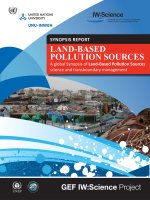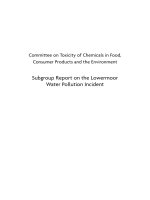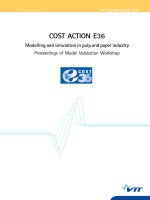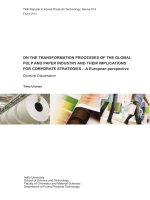Perspectives on the Pulp and Paper Industry pdf
Bạn đang xem bản rút gọn của tài liệu. Xem và tải ngay bản đầy đủ của tài liệu tại đây (8.76 MB, 42 trang )
Perspectives on the Pulp and Paper
Industry
QuickTime™ and a
TIFF (Uncompressed) decompressor
are needed to see this picture.
Douglas C. Pryke, P.Eng.
Executive Director, AET
Alliance for
Environmental Technology
QuickTime™ and a TIFF (Uncompressed) decompressor are needed to see this picture.
A Responsible Care®
Supporting Association
1
Outline
North America Pulp &
Paper Industry
Printing & Writing
Paper Market
Manufacturing
Fundamentals
Environmental
Protection
Measures of Progress
Summary
Source: Canfor Ltd.
2
N. American Pulp & Paper Industry
Bleached pulp production is
~ 35 million tons
Printing and Writing Grades
Uncoated Free Sheet
Coated Free Sheet
Uncoated Groundwood
Coated Groundwood
Printing and Writing Grades
~ 25 million tons
50% UFS
25% CFS
3
N. American Pulp & Paper Industry
US P&P industry
6% of GDP
comparable to
automotive and
plastics industries
$200 Billion Annual
Sales
1 Million employees
$54 Billion payroll
US Paper Mill Closures
Source: AF&PA
4
International Capacity Change
1998-2008
Significant
growth in
emerging
economies
Ave. Annual Change,%
North America
declining on
average 1% per
year
5
Manufacturing Fundamentals
Basic overview
Bleached kraft pulp
manufacturing
Pulping
Bleaching
Waste treatment
Environmental
Protection
QuickTime™ and a
TIFF (Uncompressed) decompressor
are needed to see this picture.
6
Manufacturing Overview
The Paper Mill Flowsheet
Logs
Sawmill Residue
Pulping Chemicals
Recovery
Debarking
Chipping
Pulping
Washing
Waste Treatment
Screening
Chemicals
Bleaching
Cleaning
Paper Machine or Pulp Dryer
7
Pulp and Paper Mill Eco-industrial Park
EcoWaste
Treatment
Fresh
Water
Wood
Fiber
Pulping
Causticizing
Chemical Recovery
Boiler
(Black Liquor)
Bleaching
Power
Generation
Power Boilers
Papermaking
Land
Application
Paper
Consumers
Power
Grid
Mine Reclamation
Sludge Stabilization
Building Products
Coal
8
Eco-industrial Park
Photo Courtesy of: Celso Foelkel, Celsius Degree 9
Minimum Impact Manufacturing
A Minimum Impact Mill:
Minimizes the number of trees used to make a piece of paper
Maximizes energy production
Minimizes water consumption, solid waste, and air emissions
Make high quality paper that is easily recyclable
Treats and disposes of waste optimally
Creates sustainable value to society
10
Minimum Impact Mill Technologies
Dry Debarking
Condensate Stripping and
Recovery
High Yield Pulping Process
Minimum SO2 and NOx
Emissions
Efficient Brownstock
Washing
Electrostatic Precipitators
Oxygen Delignification
Efficient Primary, Secondary,
and in special cases Tertiary
Waste Treatment
ECF Bleaching
Minimum Effluent Volume
Low Odour Recovery Boiler
Minimum Power Consumption
11
Maximizing Yield
Efficient wood chipping to
minimize fines and oversize
Modern digester system
Selective to lignin, preserve
cellulose
Cooking to a relatively high
lignin content (kappa no.)
Efficient knot removal and
screening system
Re-cook knots and screen
rejects - no waste
12
Bleaching in the Pulp & Paper Industry
What is Bleaching?
Turns brown pulp
Unbleached wood fibers
Raw material for brown
paper bags, cardboard
Into bleached pulp
Raw material for printing
and writing papers
Packaging
Sanitary products
13
Bleaching Flowsheet
14
Bleach Plant
15
Maximizing Yield
Selective two-stage
oxygen delignification
Excellent lignin removal
with cellulose
preservation
Elemental Chlorine-Free
(ECF) bleaching
sequence
Excellent lignin removal
with cellulose
preservation
Minimum damage to
cellulose fibres
High pulp strength
High brightness
Source: Veracel Celulose
16
High Quality Pulp for Paper
Selective two-stage oxygen
delignification
Excellent lignin removal with
cellulose preservation
Elemental Chlorine-Free (ECF)
bleaching sequence
Using chlorine dioxide, oxygen and
peroxide
Excellent lignin removal with
cellulose fibre quality preservation
High pulp strength
Excellent run-ability on paper
machines
High recycle-ability
High brightness 90% ISO
Low brightness reversion
Source: Veracel Celulose
17
A Pulp Machine
Photo Courtesy of: Celso Foelkel, Celsius Degree 18
A Paper Machine
Photo Courtesy of: Metso 19
Maximize Energy Production
Burning of bark waste in power
boiler
Efficient recovery, evaporation,
and combustion of black liquor in
recovery boiler
Recovery boiler provides 90% of
energy production; and
Mill steam requirements
Minimize within mill power
consumption with power saving
technologies such as variable
frequency drives etc.
120
Megawatts
100
80
60
In a “State-of-the-Art” mill 70% of
power generated is consumed and
30% is renewable “green” power
exported to grid
40
20
0
Produced
Consumed
Exported
20
Environmental Protection
The Call for Green Chemistry
Elemental Chlorine Free Bleaching
Eco-system Recovery
Environmental Protection Technology
Waste Treatment
Measures of Progress
21
The Call for Green Chemistry
1985 Dioxin (2378-TCDD) discovered in fish
downstream of bleached pulp mills
1987 American Forest & Paper Association (AF&PA)
and US EPA publish results of cooperative “5 Mill
Study” - confirming presence
1987-1989 research shows 2378-TCDD and 2378TCDF are formed during chlorine bleaching
Chlorination of dibenzodioxin (DBD) and dibenzofuran (DBF)
DBD and DBF were found in de-foaming agents used in
unbleached pulp preparation at that time
22
Dioxins and Furans
There are over 135 possible
Polychlorinated Dibenzo
Dioxins (PCDD) and 75
possible Polychlorinated
Dibenzofurans (PCDF)
PCDD
7
Of those, only 17 are
considered to express
“dioxin-like” toxicity
The compounds with the Cl
in the 2, 3, 7, and 8 positions
on the molecule
PCDF
7
Of the 17, only two, 2378TCDD and 2378-TCDF are
potentially produced with
chlorine bleaching
23
The Call for Green Chemistry
Chemistry that prevents pollution1:
Chemistry that eliminates or reduces the amount of any hazardous
substance, pollutant, or contaminant entering any waste stream or
otherwise released into the environment; and
reduces the hazards to public health and the environment
associated with the release of such substances, pollutants, or
contaminants.
Technology that prevents pollution:
Equipment or technology modifications, processes or procedure
modifications, reformulation or redesign of products, and substitution
of raw materials.
1.
Pollution Prevention Act of 1990. 42 USC 18101. Laws of 101st Congress - 2nd Session.
24
Green Chemistry: Found!
International research discovers:
16
Replacement of chlorine with
chlorine dioxide in the first stage
of bleaching eliminates
formation of dioxin and furan
14
12
ECF bleaching is Green
Chemistry and fits the definition
of Pollution Prevention
Technology modification with
chemical substitution
Eliminates hazardous
substances
Eliminates public and
environmental health hazard
10
Dioxin, ppq
Mills began implementing this
technology known as:
“Elemental Chlorine-Free
(ECF) Bleaching”
8
6
4
2
Not Detected
0
10
20
30
40
50
60
70
80
90 100
Chlorine Dioxide Substitution, %
25









